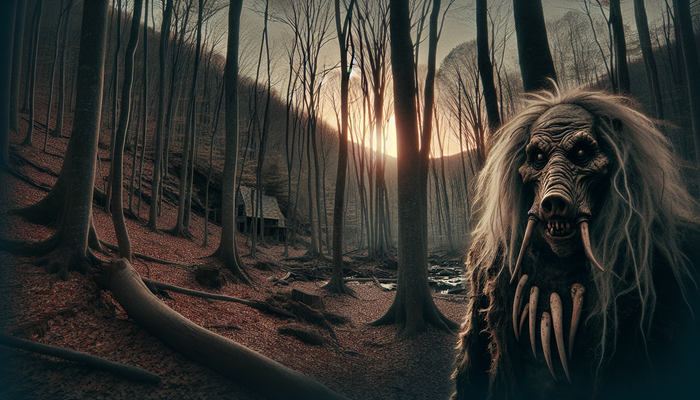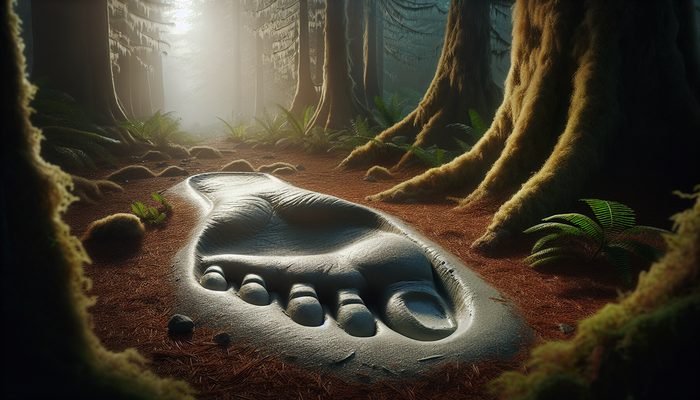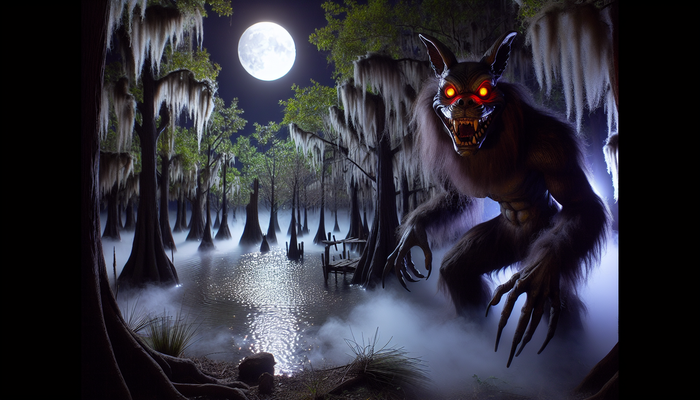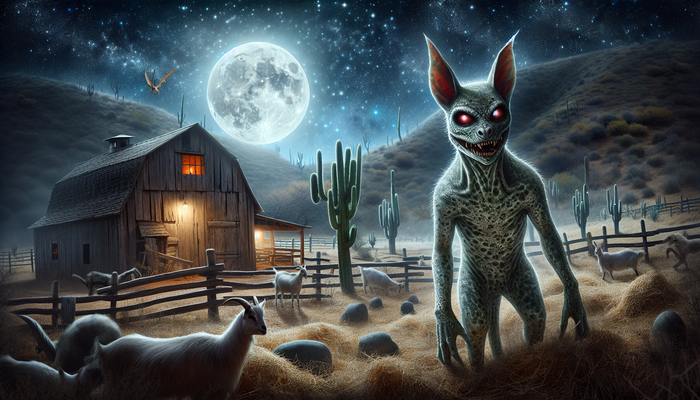The Fascinating World of South Dakota Cryptids

By Anthony Romano, Cryptozoologist
South Dakota, a state often overlooked in the world of cryptozoology, is actually a hotbed of mysterious creatures and fascinating legends. From the dapper Taku-He Bigfoot to the terrifying Miniwashitu river monster, South Dakota's diverse array of cryptids is deeply rooted in Native American folklore and the state's rugged landscapes. As a software engineer by day and a passionate cryptozoology researcher by night, I've been captivated by the unique and enigmatic creatures that call this state home. Join me as we delve into the most intriguing cryptids of South Dakota, exploring their origins, sightings, and the legends surrounding them.
Taku-He: The Well-Dressed Bigfoot of the Plains
Imagine a Bigfoot, but with a sense of style. That's Taku-He, South Dakota's very own Sasquatch, often spotted wearing a top hat and a long coat. The name "Taku-He" means "big man" in the Lakota language, and this cryptid certainly lives up to its name. Standing at an impressive 7 to 9 feet tall, Taku-He is said to roam the Black Hills and Pine Ridge Reservation, leaving behind large footprints and a trail of intrigue.
Sightings of Taku-He surged in the 1970s, particularly near Sica Hollow State Park and the Pine Ridge Reservation. In one notable incident, a film crew scouting locations for a zombie movie stumbled upon massive footprints believed to belong to the elusive creature. Locals came forward with their own tales of encountering a "big hairy man" that could cause seizures with a mere glance. Some even claimed to have found mutilated animals in the wake of Taku-He's appearances.
The origins of Taku-He remain a mystery, with theories ranging from an undiscovered primate species to a supernatural being. Regardless of its true nature, the legend of the well-dressed Bigfoot has become an integral part of South Dakota's cryptid lore, capturing the imagination of researchers and enthusiasts alike.
Miniwashitu: The Saw-Backed River Monster of the Missouri
Deep beneath the surface of the Missouri River lurks a creature so terrifying that even a glimpse of it in daylight is said to drive observers to madness. The Miniwashitu, a saw-backed river monster of Dakota folklore, is described as a rarely-seen, red-haired, buffalo-like beast with a single eye and horn protruding from its forehead. Perhaps most unsettling is the jagged, saw-like spine that runs along its back, giving the creature a truly nightmarish appearance.
According to legend, anyone unfortunate enough to witness the Miniwashitu in broad daylight is doomed to descend into insanity, ultimately leading to their untimely demise. The creature's deadly gaze is not its only peculiar attribute; it is also believed to play a role in the changing of the seasons. As spring approaches, the Miniwashitu is said to become more active, using its immense strength to break up the ice on the Missouri River, signaling the arrival of warmer days ahead.
While modern science may dismiss the Miniwashitu as mere myth, the legend has persisted for generations among the Dakota people. The fear and reverence surrounding this creature serve as a testament to the enduring power of folklore and the human fascination with the unknown.
The Lake Monsters of South Dakota
South Dakota's lakes are not just picturesque bodies of water; they are also home to an array of mysterious creatures that have captured the attention of locals and cryptozoology enthusiasts alike. From the haunted depths of Pactola Lake to the serpentine beasts of Lake Kampeska, Roy Lake, and Pickerel Lake, these aquatic cryptids add an extra layer of intrigue to the state's already rich tapestry of legendary creatures.
Pactola Lake, a man-made reservoir that submerged the town of Pactola in the 1950s, is said to be haunted by the ghost of a drowned fisherman. Visitors have reported hearing eerie cracking sounds emanating from beneath the lake's frozen surface during the winter months, as if something were trying to break through the ice. Some believe these sounds are the ghostly fisherman's attempts to escape his watery grave.
In 1886, witnesses at Lake Kampeska described seeing a massive, scaly, serpentine creature with a crested head and a whale-like tail breaching the surface. This sighting, one of the earliest recorded lake monster encounters in South Dakota, has fueled decades of speculation and investigation into the possibility of an unknown aquatic beast inhabiting the lake.
More recently, jet skiers and fishermen at Roy Lake and Pickerel Lake have reported spotting enormous, eel-like creatures up to the length of a canoe. These sightings have reignited interest in South Dakota's lake monsters and have sparked new debates about the potential existence of undiscovered aquatic species in the region's waters.
The Badlands Banshee: A Wailing Spirit of the Rugged Wilderness
In the rugged wilderness of South Dakota's Badlands, a ghostly figure is said to wander the desolate landscape, her mournful wails echoing through the canyons. Known as the Badlands Banshee, this spectral woman is described as having long, unkempt hair and wearing a flowing white dress. She is most often spotted near Watch Dog Butte, where she is believed to materialize to attract the attention of unsuspecting passersby.
The origins of the Badlands Banshee are shrouded in mystery, with conflicting tales of her life and death. Some say she was a settler woman killed by Native Americans, while others claim she was an indigenous woman murdered by settlers. Regardless of her true identity, the banshee's presence in the Badlands has become an integral part of the region's folklore.
Encounters with the Badlands Banshee are said to be both terrifying and mesmerizing. Witnesses report being drawn to her plaintive cries, only to be shocked when she vanishes with a piercing scream upon their approach. The eerie silence that follows is a stark reminder of the Badlands' haunting beauty and the secrets that lie hidden within its rugged terrain.
Wendigo: The Cannibalistic Creature of Legend
The Wendigo, a gaunt, pale creature with an insatiable hunger for human flesh, is a chilling figure in South Dakota folklore. According to legend, the Wendigo was once human but became cursed after resorting to cannibalism in times of desperation. Now, it roams the forests and plains, forever seeking to satisfy its grotesque cravings.
One of the most famous Wendigo hunters was Jack Fiddler, a Cree man who claimed to have slain 14 of these creatures in his lifetime. In 1907, Fiddler and his son faced trial for the murder of a Cree woman whom they believed was on the verge of transforming into a Wendigo. Fiddler argued that if he had not taken action, the woman would have succumbed to the curse and slaughtered the entire village.
The legend of the Wendigo serves as a powerful cautionary tale against the dangers of greed and gluttony. It is a reminder of the darkness that can lurk within the human heart and the terrible consequences that can befall those who succumb to their basest instincts. The Wendigo's presence in South Dakota lore is a testament to the enduring power of these ancient warnings and the importance of preserving the wisdom of the past.
Sica Hollow: The "Evil" Forest of Haunting Legends
Nestled in the northeast corner of South Dakota lies Sica Hollow, a forest steeped in haunting legends and mysterious phenomena. The Sioux people, who once inhabited the area, dubbed this place "sica," meaning "evil," and refused to hunt within its boundaries. The reason for their fear becomes apparent upon closer examination of the forest's eerie characteristics and the tales that have emerged from its depths.
One of the most striking features of Sica Hollow is the reddish hue of its water, which the Sioux believed to be the blood and flesh of their ancestors. Modern science attributes this coloration to the high mineral content of the springs and creeks, but the unsettling appearance remains a testament to the forest's sinister reputation.
Visitors to Sica Hollow have reported a wide range of paranormal activity, from the soft glow of phosphorescent trees to the heart-stopping sight of a Bigfoot-like creature lurking in the shadows. Some have even claimed to hear the ghostly echoes of war cries and the anguished screams of those who met their untimely end within the forest's borders. The 1970s saw a surge in Bigfoot sightings and unexplained disappearances, further cementing Sica Hollow's status as a hotbed of supernatural activity.
As a researcher, I find myself drawn to the enigmatic nature of Sica Hollow and the many secrets it holds. The forest's ability to captivate the imagination and evoke a sense of primordial fear is a testament to the enduring power of folklore and the human fascination with the unknown. Whether the legends of Sica Hollow are rooted in reality or are merely the product of generations of storytelling, there is no denying the forest's ability to leave an indelible mark on all who dare to venture into its haunting depths.
The Haunting of Deadwood's Bullock Hotel
In the historic town of Deadwood, South Dakota, the Bullock Hotel stands as a testament to the region's rich and often turbulent past. Once owned by Seth Bullock, Deadwood's first sheriff, the hotel is now known for its ghostly inhabitants, particularly the spirit of Bullock himself. The spectral sheriff is said to roam the halls of his former establishment, leaving behind traces of his presence in the form of phantom footsteps and the lingering scent of cigar smoke.
Guests and staff at the Bullock Hotel have reported a wide range of eerie occurrences, from the unsettling sensation of being watched by unseen eyes to the startling appearance of a ghostly figure seated at the bar. Many attribute these strange happenings to the restless spirit of Seth Bullock, who perhaps feels a sense of unfinished business in the town he once worked so hard to tame.
Deadwood's violent history, marked by the infamous shooting of Wild Bill Hickok and the town's lawless reputation, may contribute to the Bullock Hotel's haunted atmosphere. The echoes of the past seem to linger in every corner of the building, whispering tales of the men and women who once walked its halls and shaped the destiny of this legendary town.
As an investigator of the paranormal, I am fascinated by the Bullock Hotel and the many stories that surround it. The idea that a spirit as strong-willed and determined as Seth Bullock could continue to watch over his beloved town long after his passing is a testament to the enduring power of the human spirit and the indelible mark that certain individuals leave on the places they once called home.
The Slide-Rock Bolter: A Lumberjack's Tall Tale Come to Life
Deep in the forests of the Black Hills, a group of lumberjacks once gathered around a crackling campfire, spinning tales of the strange and fantastic creatures that lurked in the shadows of the towering pines. Among these stories was that of the Slide-Rock Bolter, a massive, whale-like beast with a cavernous mouth and an insatiable appetite for destruction.
According to the lumberjacks' tales, the Slide-Rock Bolter would perch atop the highest peaks of the Black Hills, waiting for an unsuspecting victim to wander into the valleys below. When the moment was right, the creature would tuck in its tail and hurl itself down the mountainside, reaching incredible speeds as it careened toward its prey. With its gaping maw open wide, the Slide-Rock Bolter would scoop up anything in its path, from hapless animals to entire trees, before coming to a rest at the base of the valley, ready to begin its ascent anew.
While the Slide-Rock Bolter was most likely a product of the lumberjacks' vivid imaginations and their desire to pass the time with a good yarn, the creature's bizarre appearance and larger-than-life persona have earned it a place in South Dakota's pantheon of legendary beasts. The image of a massive, whale-like creature hurtling down a mountainside, its jaws agape and ready to devour all in its path, is one that has captured the imagination of generations of Black Hills residents and visitors alike.
As a researcher of cryptids and folklore, I find the Slide-Rock Bolter to be a fascinating example of how tall tales and legends can take on a life of their own, blurring the lines between reality and fiction. The fact that this creature, born from the imaginations of a group of lumberjacks huddled around a campfire, has endured for so long is a testament to the power of storytelling and the human need to explain the unknown and the fantastic.
Devil's Tower: A Sacred Site Steeped in Legend
Rising majestically from the plains of northeastern Wyoming, just a stone's throw from the South Dakota border, stands Devil's Tower, an awe-inspiring geological formation that has captured the imaginations of Native American tribes and modern-day visitors alike. This towering butte, composed of igneous rock, is not only a striking visual landmark but also a sacred site steeped in ancient legend.
The Kiowa people tell a tale of seven sisters who, while being chased by a giant bear, were lifted to safety by the Great Spirit. As the sisters ascended, the ground beneath them rose up, forming the tower we see today. The bear, determined to reach its prey, left deep claw marks on the sides of the newly-formed butte, which remain visible to this day. The seven sisters, according to the legend, were eventually placed in the sky, becoming the stars of the Big Dipper constellation.
The Lakota people share a similar legend, in which two boys, fleeing from a ravenous bear, pray to the Great Spirit for help. In response, the ground beneath the boys' feet begins to rise, lifting them out of harm's way. The bear, unable to climb the sheer sides of the growing tower, leaves its claw marks on the rock as it futilely attempts to reach the boys.
These legends, passed down through generations, serve as a testament to the deep spiritual significance that Devil's Tower holds for the Native American tribes of the region. The stories not only provide an explanation for the tower's unique appearance but also offer insight into the beliefs and values of the people who have called this land home for countless generations.
As a researcher, I am fascinated by the way in which these ancient legends have become intertwined with the natural world, imbuing the landscape with a sense of mystery and wonder. The stories surrounding Devil's Tower serve as a reminder of the rich cultural heritage that exists in the Black Hills region and the importance of preserving these tales for future generations.
Skinwalkers: Shapeshifting Witches of the Black Hills
In the shadowy recesses of South Dakota's Black Hills, whispers of a terrifying creature known as the Skinwalker have long haunted the imaginations of those who call this region home. These shapeshifting witches, deeply feared in Navajo lore, are said to possess the power to transform into animals, using their supernatural abilities to wreak havoc and sow discord among the living.
From Bigfoot to UFOs: Hangar 1 Publishing Has You Covered!
Explore Untold Stories: Venture into the world of UFOs, cryptids, Bigfoot, and beyond. Every story is a journey into the extraordinary.
Immersive Book Technology: Experience real videos, sights, and sounds within our books. Its not just reading; its an adventure.



























